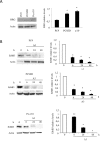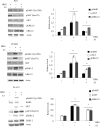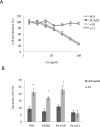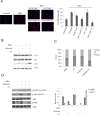Combination therapy with anti-ErbB3 monoclonal antibodies and EGFR TKIs potently inhibits non-small cell lung cancer
- PMID: 23896512
- PMCID: PMC3787155
- DOI: 10.18632/oncotarget.1141
Combination therapy with anti-ErbB3 monoclonal antibodies and EGFR TKIs potently inhibits non-small cell lung cancer
Abstract
Personalized therapy of advanced non-small cell lung cancer (NSCLC) has been improved by the introduction of EGFR tyrosine kinase inhibitors (TKIs), gefitinib and erlotinib. EGFR TKIs induce dramatic objective responses and increase survival in patients bearing sensitizing mutations in the EGFR intracytoplasmic tyrosine kinase domain. However, virtually all patients develop resistance, and this is responsible for disease relapse. Hence several efforts are being undertaken to understand the mechanisms of resistance in order to develop combination treatments capable to sensitize resistant cells to EGFR TKIs. Recent studies have suggested that upregulation of another member of the EGFR receptor family, namely ErbB3 is involved in drug resistance, through increased phosphorylation of its intracytoplasmic domain and activation of PI3K/AKT signaling. In this paper we first show, by using a set of malignant pleural effusion derived cell cultures (MPEDCC) from patients with lung adenocarcinoma, that surface ErbB3 expression correlates with increased AKT phosphorylation. Antibodies against ErbB3, namely A3, which we previously demonstrated to induce receptor internalization and degradation, inhibit growth and induce apoptosis only in cells overexpressing surface ErbB3. Furthermore, combination of anti-ErbB3 antibodies with EGFR TKIs synergistically affect cell proliferation in vitro, cause cell cycle arrest, up-regulate p21 expression and inhibit tumor growth in mouse xenografts. Importantly, potentiation of gefitinib by anti-ErbB3 antibodies occurs both in de novo and in ab initio resistant cells. Anti-ErbB3 mAbs strongly synergize also with the dual EGFR and HER2 inhibitor lapatinib. Our results suggest that combination treatment with EGFR TKI and antibodies against ErbB3 should be a promising approach to pursue in the clinic.
Figures







Similar articles
-
Curcumin induces EGFR degradation in lung adenocarcinoma and modulates p38 activation in intestine: the versatile adjuvant for gefitinib therapy.PLoS One. 2011;6(8):e23756. doi: 10.1371/journal.pone.0023756. Epub 2011 Aug 17. PLoS One. 2011. PMID: 21858220 Free PMC article.
-
Targeting the epidermal growth factor receptor in non-small cell lung cancer cells: the effect of combining RNA interference with tyrosine kinase inhibitors or cetuximab.BMC Med. 2012 Mar 21;10:28. doi: 10.1186/1741-7015-10-28. BMC Med. 2012. PMID: 22436374 Free PMC article.
-
Combined vascular endothelial growth factor receptor and epidermal growth factor receptor (EGFR) blockade inhibits tumor growth in xenograft models of EGFR inhibitor resistance.Clin Cancer Res. 2009 May 15;15(10):3484-94. doi: 10.1158/1078-0432.CCR-08-2904. Epub 2009 May 15. Clin Cancer Res. 2009. PMID: 19447865 Free PMC article.
-
Acquired resistance of lung adenocarcinoma to EGFR-tyrosine kinase inhibitors gefitinib and erlotinib.Cancer Biol Ther. 2010 Apr 15;9(8):572-82. doi: 10.4161/cbt.9.8.11881. Epub 2010 Apr 26. Cancer Biol Ther. 2010. PMID: 20404520 Review.
-
Epidermal growth factor receptor (EGFR) targeted therapies in non-small cell lung cancer (NSCLC).Rev Recent Clin Trials. 2006 Jan;1(1):1-13. doi: 10.2174/157488706775246157. Rev Recent Clin Trials. 2006. PMID: 18393776 Review.
Cited by
-
The natural compound fucoidan from New Zealand Undaria pinnatifida synergizes with the ERBB inhibitor lapatinib enhancing melanoma growth inhibition.Oncotarget. 2017 Mar 14;8(11):17887-17896. doi: 10.18632/oncotarget.14437. Oncotarget. 2017. PMID: 28060735 Free PMC article.
-
Redundant kinase activation and resistance of EGFR-tyrosine kinase inhibitors.Am J Cancer Res. 2014 Nov 19;4(6):608-28. eCollection 2014. Am J Cancer Res. 2014. PMID: 25520855 Free PMC article. Review.
-
Potential therapeutic benefit of combining gefitinib and tamoxifen for treating advanced lung adenocarcinoma.Biomed Res Int. 2015;2015:642041. doi: 10.1155/2015/642041. Epub 2015 Jan 26. Biomed Res Int. 2015. PMID: 25692143 Free PMC article. Clinical Trial.
-
EGFR-TKI resistance in NSCLC patients: mechanisms and strategies.Am J Cancer Res. 2014 Sep 6;4(5):411-35. eCollection 2014. Am J Cancer Res. 2014. PMID: 25232485 Free PMC article. Review.
-
MicroRNAs in melanoma development and resistance to target therapy.Oncotarget. 2017 Mar 28;8(13):22262-22278. doi: 10.18632/oncotarget.14763. Oncotarget. 2017. PMID: 28118616 Free PMC article. Review.
References
-
- Jemal A, Bray F, Center MM, Ferlay J, Ward E, Forman D. Global cancer statistics. CA Cancer J Clin. 2011;61(2):69–90. - PubMed
-
- Heffernan KS, Wanke CA, Dong K, Warner PJ, Anskat PE, Karas RH, Kuvin JT. Lung cancer stem cells: tumor biology and clinical implications. Asia Pac J Clin Oncol. 2012;8:217–22. - PubMed
-
- Saintigny P, Burger JA. Recent advances in non-small cell lung cancer biology and clinical management. Discov Med. 2012;13:287–97. - PubMed
Publication types
MeSH terms
Substances
LinkOut - more resources
Full Text Sources
Other Literature Sources
Medical
Research Materials
Miscellaneous

